ISSN ONLINE(2278-8875) PRINT (2320-3765)
ISSN ONLINE(2278-8875) PRINT (2320-3765)
Dr.Tarlochan Kaur1 and Sandeep Kakran2
|
Visit for more related articles at International Journal of Advanced Research in Electrical, Electronics and Instrumentation Engineering
Power system stability is defined as the ability of power system to preserve it’s steady stability or recover the initial steady state after any deviation of the system’s operation. Present time power systems are being operated nearer to their stability limits due to economic and environmental reasons. Maintaining a stable and secure operation of a power system is therefore a very important and challenging issue. Transient stability has been given much attention by power system researchers and planners in recent years, and is being regarded as one of the major sources of power system insecurity. Shunt FACTS devices play an important role in improving the transient stability, increasing transmission capacity and damping low frequency oscillations. In this paper shunt FACTS device-SVC is used in a two area power system for improving the transient stability. MATLAB software has been used in this study.
Keywords |
| FACTS, long transmission line, MATLAB, SVC, transient stability, three phase fault. |
INTRODUCTION |
| Transmission networks of present power systems are becoming progressively more stressed because of increasing demand and limitations on building new lines. One of the consequences of such a stressed system is the risk of losing stability following a disturbance. Flexible ac transmission system (FACTS) devices are found to be very efficient in a stressing transmission network for better utilization of its existing facilities without sacrificing the desired stability margin. Flexible AC Transmission System (FACTS) controllers, such as Static VAR Compensator (SVC) and Static Synchronous Compensator uses the latest technology of power electronic switching devices in electric power transmission systems to control voltage and power flow, and play an important role as a stability aid for and transient disturbances in an interconnected power systems. |
| The literature shows an increasing interest in this subject for the last two decades, where the enhancement of system stability using FACTS controllers has been extensively investigated. This paper presents the improvement of transient stability of a two area power system with a SVC. Transient stability improvement is necessary from the view point of maintaining system security that is the occurrence of a fault should not lead to tripping of generating unit due to loss of synchronism. SVC has the ability of improving stability and damping by dynamically controlling it’s reactive power output. The transient stability improvement of the two area system with different loading conditions is investigated in this work. |
| This paper is organized as follows: Section I gives the introduction of FACTS devices for enhancing transient stability of long transmission line system. Section II is helpful to understand the background of related work. Section III explains the system modeling. Sections IV shows results of the proposed technique and the last section concludes the paper followed by the References. |
SHUNT FACTS DEVICE SVC |
| According to definition of IEEE PES Task Force of FACTS Working Group: Static VAr Compensator (SVC): A shuntconnected static var generator or absorber whose output is adjusted to exchange capacitive or inductive current so as to maintain or control specific parameters of the electrical power system (typically bus voltage). This is a general term for a Thyristor Controlled Reactor (TCR) or Thyristor Switched Reactor (TSR) and/or Thyristor Switched Capacitor (TSC) Fig. 1. The term, “SVC” has been used for shunt connected compensators, which are based on thyristors without gate turn-off capability. It includes separate equipment for leading and lagging vars; the thyristor –controlled or thyristor – switched reactor for absorbing reactive power and thyristor – switched capacitor for supplying the reactive power. V-I characterstics of SVC are shown in the figure 2. |
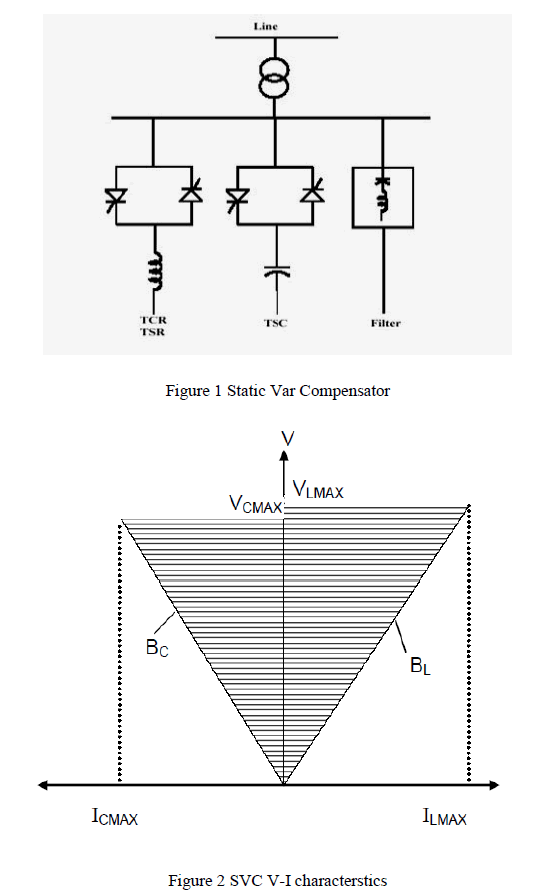 |
Power modulation by SVC in transmission line |
| The real power flow through a transmission line with a SVC located at the middle of the line, Fig. 3 is described by: |
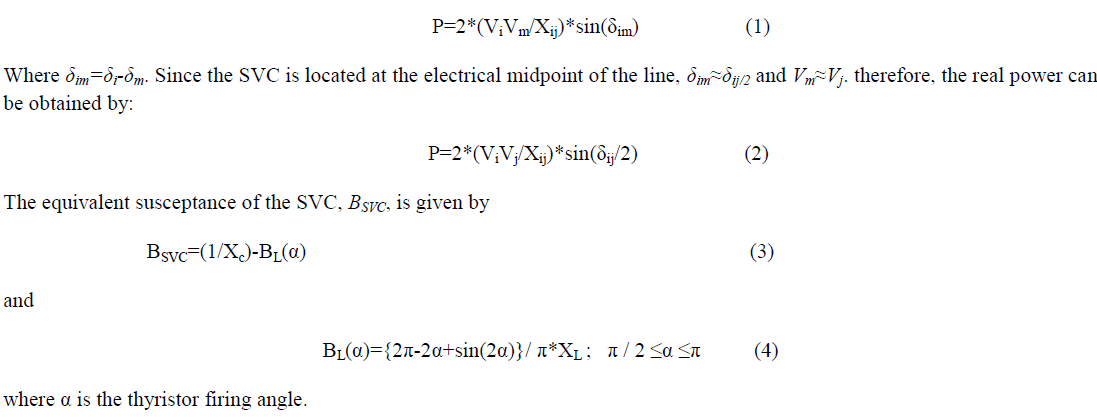 |
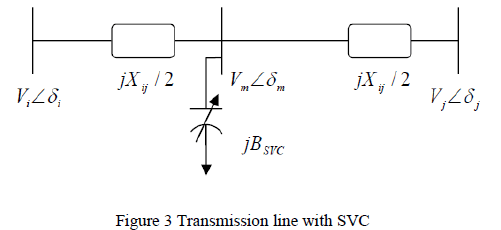 |
| The SVC can be seen as a dynamic source of reactive current having sub-cycle reaction time. Using the thyristor valve as fast switches, capacitor banks can be switched in and out. This arrangement of switching capacitors and controlling reactors provides regular control of the reactive current output between two extremes dictated by component rating selection. |
| Electrical loads both generate and absorb reactive power. Since the transmitted load varies significantly from one hour to another, the reactive power equilibrium in a grid varies as well. The result can be undesirable voltage amplitude variations, a voltage depression, or even a voltage collapse. |
| A rapidly operating Static Var Compensator (SVC) can regularly provide the reactive power necessary to control dynamic voltage swings under different system conditions and thereby improve the power system transmission and distribution performance. Installing an SVC at one or more appropriate points in the network will enhance transfer capability through improved voltage stability, while maintaining a smooth voltage profile under different network conditions. In addition, an SVC can diminish active power oscillations through voltage amplitude modulation. |
| Thus the principal benefit of the SVC for transient stability enhancement is direct and rapid bus voltage control. In particular, the SVC may be used to enhance power transfer during low-voltage conditions which typically predominate during faults, decreasing the acceleration of local generators which may otherwise occur. |
SYSTEM MODELLING |
| To show the transient stability improvement by SVC in a two area power system, a model of two area system is designed in MATLAB AS SHOWN IN Figure 3.. In this model a 1000 MW power plant-1 is connected with another 1200 MW power plant-2 through a long 400 kV, 400 km transmission line. Both the plants are supplying the power to different loads in different case studies i.e. in first case the load is 1475 MW pure resistive and connected at bus B3 of the system, in the second case load is inductive with 1700 MW, 500 MVAr ratings and connected at bus B3 of the system and in the third case two inductive loads of rating 500 MW, 150 MVAr and 1100 MW, 500 MVAr are connected at bus B1 and B3 of the system . Simulation is performed for 12 sec.and a three phase fault is applied from 5.0 sec to 5.1 sec in each case. A stop block is used to stop the simulation when the angle difference becomes 3*360 degree.. |
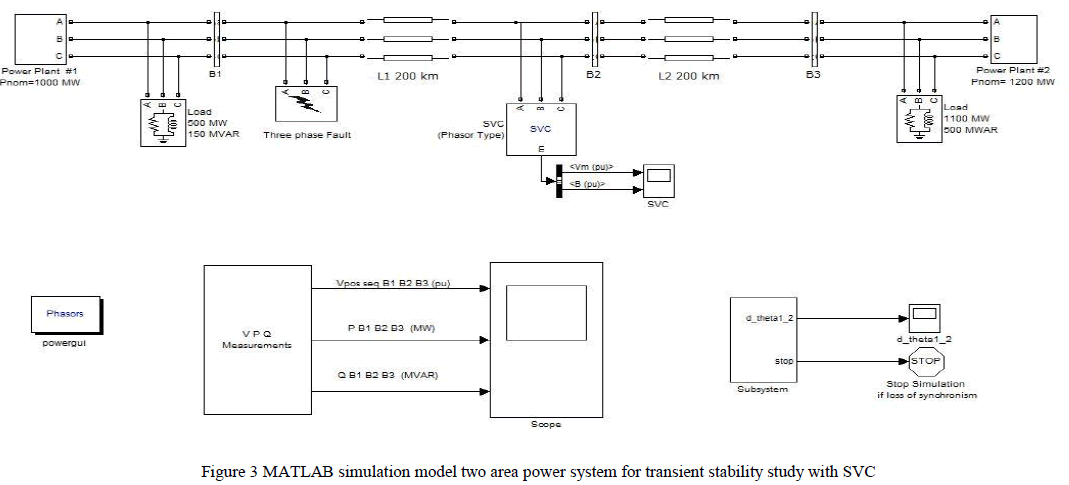 |
SIMULATION AND RESULTS |
| When models are all the three cases of different loads, simulated without SVC then it is observed from Figure 4, Figure 9 and Figure 14 respectively that large transients occur in rotor angle difference of machines. in line voltage, in line active power and in line reactive power. With SVC, there is marked reduction in rotor angle difference in all the three case as is evident from Figure 5, Figure 10 and Figure 15 respectively. Line voltages, line active powers and line reactive powers at buses 1,2,3 are shown in Figure 6-8, Figure 11-13 and Figure 16-18 for three load cases respectively. |
| Results related to model with pure resistive load at bus B3 are shown in fig. 4-8. |
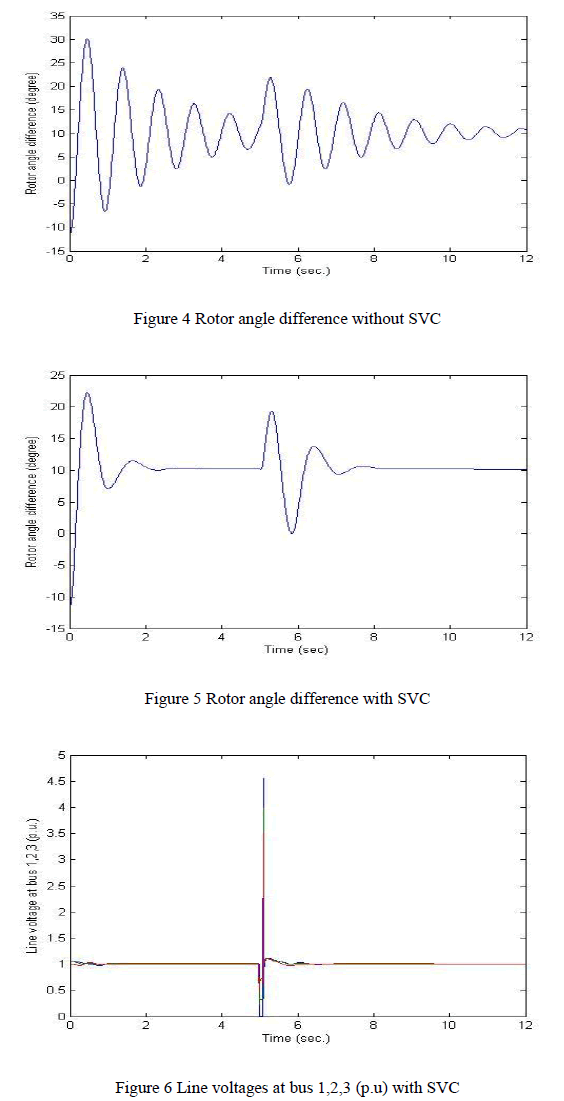 |
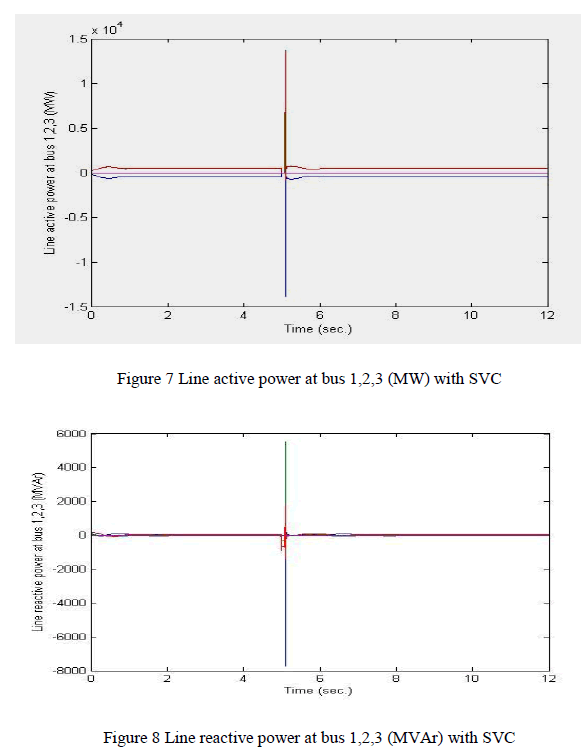 |
| Results related to model with Inductive load at bus B3 are shown in fig. 9-13. |
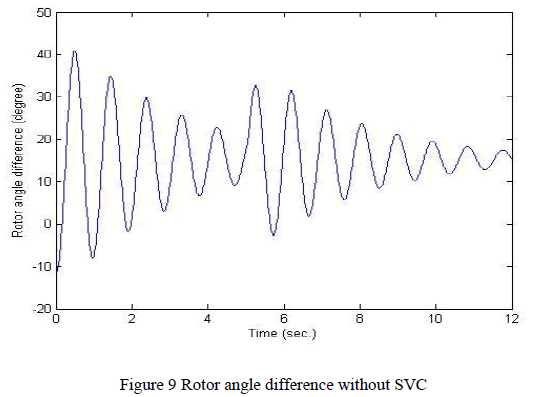 |
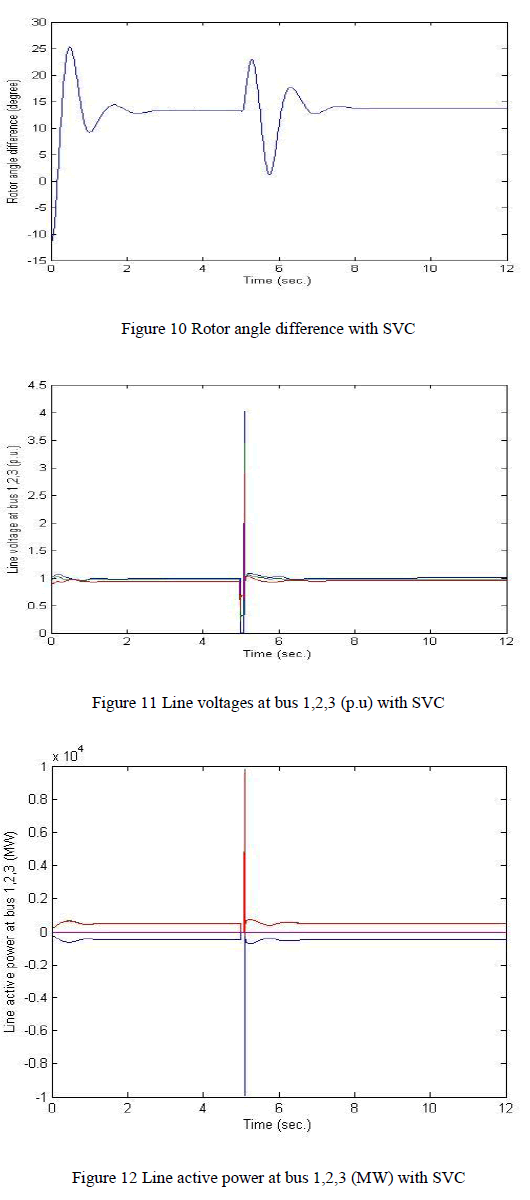 |
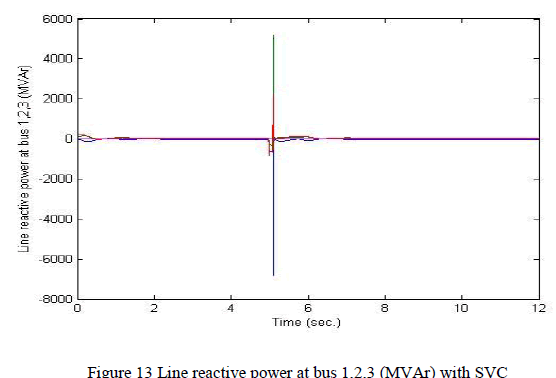 |
| Results related to model with Inductive load at bus B1 and B3 are shown in fig. 14-18. |
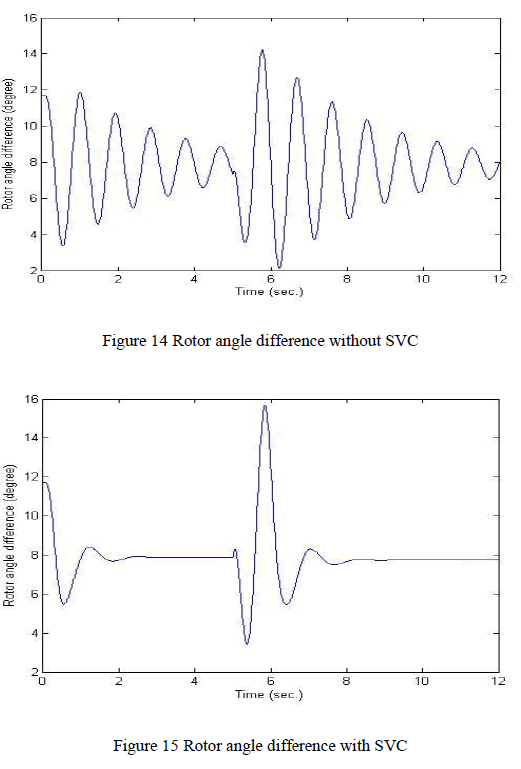 |
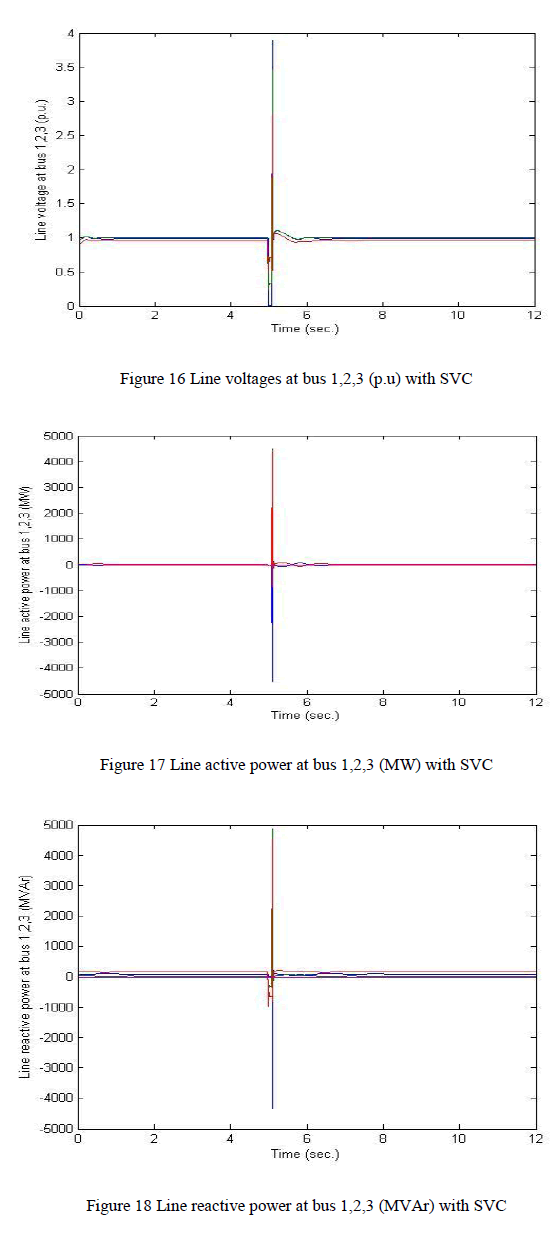 |
CONCLUSION |
| In this paper a two area power system with various loads connected at different buses in different cases is studied by making a simulink model in MATLAB. The usefulness of SVC has been studied in improving the transient stability of the above stated network. It is found in the study that the transient stability of the system is highly affected by SVC. After clearing the fault high transients had appeared in rotor angle difference of two machines, in transmission line voltage and power when SVC was not connected in the line. But after connecting SVC in the line, transient period has decreased to a significant value for above parameter of transmission line in figure 4-18. Thus it can be concluded that the transient stability of two area power system with different loads at different buses improves by using SVC. |
References |
|